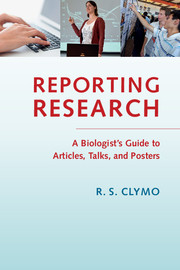7 - Quantitative matters
Published online by Cambridge University Press: 05 October 2014
Summary
If you never quote a numerical value, never use units, never use graphs, and never write equations then you can safely skip this chapter.
Numerical values
The meaning and usage of ‘number’, ‘numeral’, ‘digit’, ‘value’, and ‘figure’ is not entirely clear.
‘Number’ has the broadest meaning. Illuminating accounts of the relationships between different sorts of number – integer, rational, irrational, imaginary, complex, transcendental – are given in Feynmann, Leighton, & Sands (1963) and in Sondheimer & Rogerson (1981). ‘Number’ is commonly used as well for counted items: ‘The number of sheep’, and in a general sense as in ‘the numbers show …’.
‘Value’ applies to variables, variates, parameters, and constants. (The proper expression of such a value is considered later in this chapter.) Each has a ‘value’ that comprises two components: a number and zero or more units, as in ‘24.6 mg’. In most places in this book I use ‘numerical value’ for the number part of the overall value to emphasise this point, but the simple ‘value’ is widely used for the numerical component alone.
‘Numeral’ is most often used for Roman quantities (as in dates such as MCCCCLVIII).
‘Digit’ is one of the single Arabic symbols ‘0’ … ‘9’ corresponding to human fingers or toes. Thus all real numbers can be expressed as a combination of Arabic digits with the symbols ‘+’, ‘–’, ‘.’ and perhaps ‘e’, or ‘E’, or ‘×’.
‘Figure’ is unclear, and has a different and specific use for illustrations, so is best kept for them alone.
- Type
- Chapter
- Information
- Reporting ResearchA Biologist's Guide to Articles, Talks, and Posters, pp. 189 - 210Publisher: Cambridge University PressPrint publication year: 2014



